Table of contents
- Report clothing and accessories production Who produces what and where?
- China is no longer a low-wage country
- Wage increase of around 20 percent per year
- Cost share in percent (based on the dealer purchase price)
- Countries of manufacture (using the example of the Polo motorcycle)
- interview
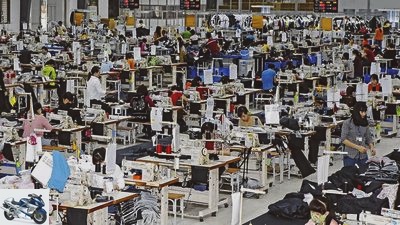
Stefan Wolf
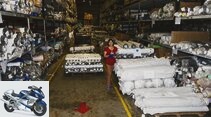
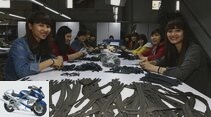
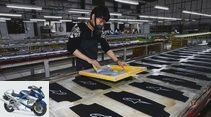
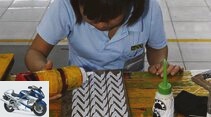
16 pictures
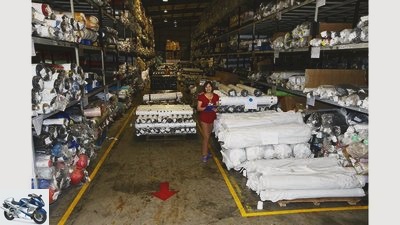
Stefan Wolf
1/16
Phan Thi Ha (30) is the boss of 60 employees in the 2160 m², multi-storey KIDO raw materials warehouse (“warehouse”).

Stefan Wolf
2/16
In the warehouse, Pham Bich Ngoc (23, left) and Hoang Phi Viu (25, right) and their colleagues assemble zippers.
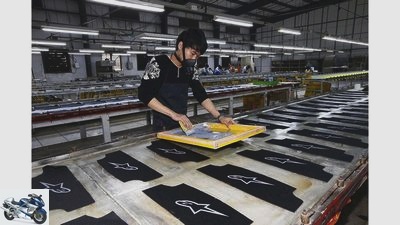
Stefan Wolf
3/16
Ha Dang Tink (26) applies brand logos to upper materials using screen printing and respiratory protection (here for Alpinestars).
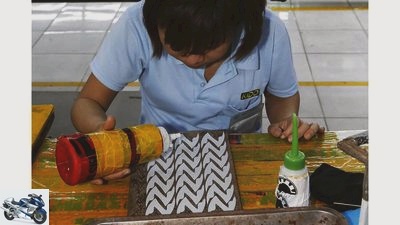
Stefan Wolf
4/16
The injection of brand logos from silicone is real manual work. The 26-year-old Trinh Thi Ngoan is a specialist in this.
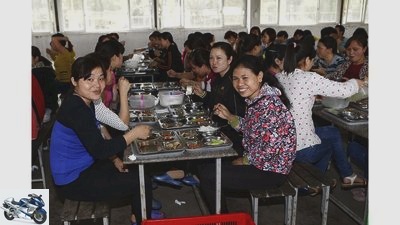
Stefan Wolf
5/16
There is a lunch break from 12 p.m. to 1 p.m. Around 1200 KIDO employees come to tables that have already been set in a large hall.
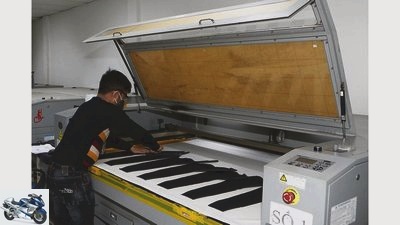
Stefan Wolf
6/16
The laser cutting provides ventilation holes in the outer fabric, among other things, and KIDO has ten machines. This is served by Trinh Van Bang (23).
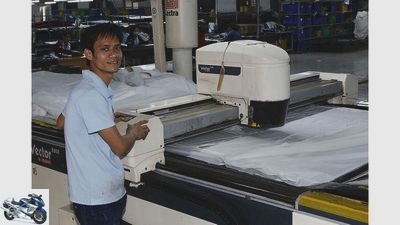
Stefan Wolf
7/16
In the automatic cutting machine from Dao Va Muoc (30), several layers of fabric (here: thermal lining) fit on top of each other (max. 5 cm).
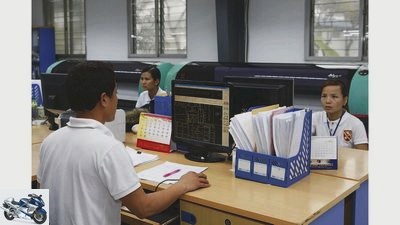
Stefan Wolf
8/16
The men and women who feed the computer with blanks to save space are the best-paid KIDO employees.
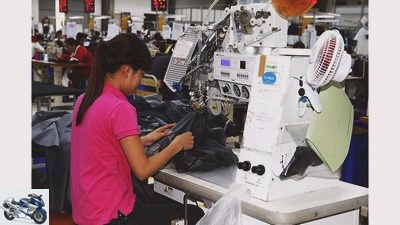
Stefan Wolf
9/16
Another sensitive area: taping, the waterproof sealing of the seams. Ho Thi Anh (24) on one of 120 machines.
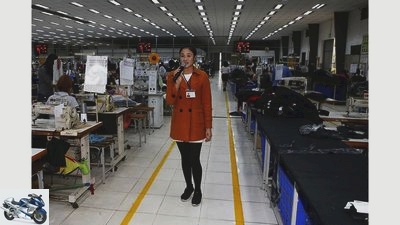
Stefan Wolf
10/16
Hathi Phuong (33) is the division manager in the sewing room and coordinates the material replenishment via micro-moderation.
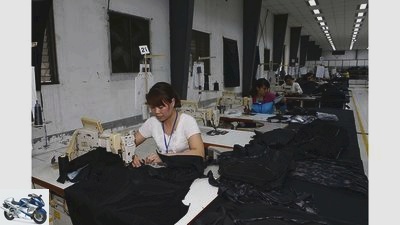
Stefan Wolf
11/16
Around 600 seamstresses in 15 production lines ensure that 130 pieces are turned into a jacket, for example.
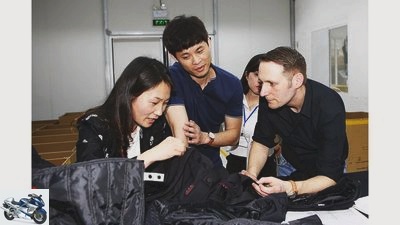
Stefan Wolf
12/16
Melody Zhong (34, left) and her colleagues from the Polo Quality Assurance Office in Shanghai regularly check every detail on site.
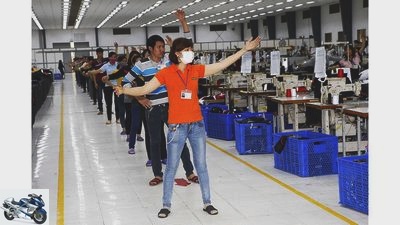
Stefan Wolf
13/16
Group gymnastics is announced several times a day in the sewing room, after which the broom is swung briefly at each place.
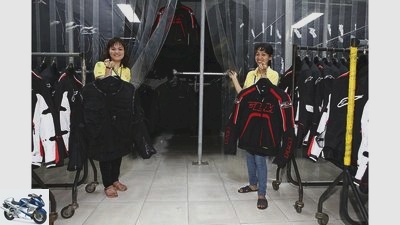
Stefan Wolf
14/16
Before packing, the clothing is placed in the drying room of Le Thi Thuong (33, left) and Trinh Thi Twyen (30) for 48 hours.
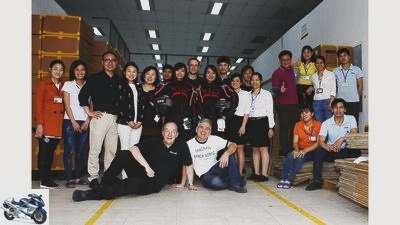
Stefan Wolf
15/16
These friendly people showed MOTORRAD how a jacket is made. Totally on the ground: photographer (right) and author.

Stefan Wolf
16/16
At 4.30 p.m. it is over after nine hours (including lunch). Almost all employees live nearby and drive scooters.
clothing
Report clothing and accessories production
Report clothing and accessories production
Who produces what and where?
What was planned as a harmless visit to a textile clothing manufacturer turns out to be a lesson in terms of global networking. Who actually produces what in the motorcycle accessories market and where? A search for traces in the far east.
Klaus Herder
07/07/2016
Two long noses on a research tour in China: My photographer Stefan and I are on the road with lithium-ion batteries to collect background information for a battery test planned later in the year. We are in good time and let the polo buyers who are also there persuade us to take a trip to Vietnam. “Take a look at our textile production there, you will be surprised!” Yes, no, that’s clear. About ten years ago Stefan and I produced various China industrial reports, what should be so very different in the low-wage country of Vietnam? Anyway, we’re already halfway there, so let’s take the Vietnam story with us. Quasi bycatch, you might need it at some point.
Buy complete article
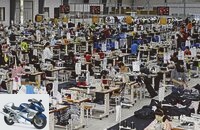
Report clothing and accessories production
Who produces what and where?
4 pages) as PDF
€ 2.00
Buy now
Change of location: Two days later we are in a clothing factory in northern Vietnam, around 40 kilometers east of the capital Hanoi. The Korean company KIDO has been operating a textile production facility here since 2006 on an area of 60,000 m². Around 1200 employees ensure that around 80,000 jackets, pants and other outdoor and motorcycle clothing items are produced every month. KIDO, founded in Seoul / South Korea in 1980 and still family-owned, is one of the big names on the market, and probably number one in the motorcycle sector. With further factories in Vietnam, China and Indonesia, the Koreans employ a total of around 10,000 people. The customer list reads like a who’s who in the industry: Alpinestars, Dainese, Firstgear, Icon, Motoport, Rev’it, Scott, BMW, Harley-Davidson, Triumph and of course Polo – all of these and many others are made here. The outdoor area is also well-known with Jack Wolfskin, Barbour, Engelbert Strauss, Schoffel, Ziener and Bergans, among others.
China is no longer a low-wage country
In 2004 I was for the last time in a KIDO factory, a leather processing company in China. That was quite impressive at the time: tightly organized, a relatively modern machine park and working conditions that were considered quite progressive by Far Eastern standards. At the time, a leather seamstress earned 70 to 90 US dollars net per month and lived in a shared room in a dormitory attached to the factory. Compared to what we are now seeing in Vietnam, however, the Chinese factory was a garment manufacturing stone age. KIDO Hanoi is a different world: modern, bright halls, clean and well-ventilated workplaces, state-of-the-art machines that some southern European companies would be quite jealous of, and a workforce that seems much more self-confident and livelier than their Chinese colleagues twelve years ago. Vietnam is clearly lagging behind China in terms of economic development and is practically China’s low-wage successor. So a lot must have happened in the last decade.
It also has. And huge. First of all, when it comes to wages: China is – at least for the motorcycle clothing industry – no longer a low-wage country. The said Chinese seamstress now earns between 450 and 500 US dollars a month, has health and pension insurance and can no longer be fobbed off with a six-bed room in the dormitory. Skilled workers – and only those are mentioned in this story – are in short supply and can choose their jobs in China. This development was foreseeable around ten years ago and prompted companies like KIDO to move on. For example to Indonesia or Vietnam. There were even then countries in which the wage level was even lower (Bangladesh as the still inglorious example of the textile industry today), but something very crucial was missing in such countries (and is still missing as in India, for example, to this day): infrastructure. The lowest wage level is of little help if the raw material cannot be reliably brought to the factory and the finished product cannot be brought quickly to the port.
Wage increase of around 20 percent per year
Planned economies like Vietnam have learned a lot from China in this regard. The state built wide roads and laid out extensive industrial areas before the first investor was even approached. There is also a “mentality advantage”. The Southeast Asian himself – to sum it up wonderfully – has understood that upswing and prosperity are associated with work. “Nothing comes from anything” – this also applies to willingness to learn. The greatest good for parents in the Far East? Education for their children. It looks different in countries in which – to put it mildly – religion plays a greater role. Take Pakistan, for example: a country with an incredible amount of technical know-how, also and especially in terms of leather processing. And a country with active entrepreneurs in the best British merchant tradition. But also a country with certain problems in terms of work ethics and with little infrastructure support from the state.
Back to Vietnam: Today a KIDO seamstress earns around 120 US dollars net per month. The (state-prescribed) wage increase is currently around 20 percent per year. It can therefore be foreseen that the caravan will move on in the not too distant future, because at least the clothing production will be too expensive. Countries like Myanmar are already in the starting blocks. Do we have to worry about the incredibly friendly Vietnamese? Hardly, the example of China shows: There is an (economic) life after the low-wage period.
Cost share in percent (based on the dealer purchase price)
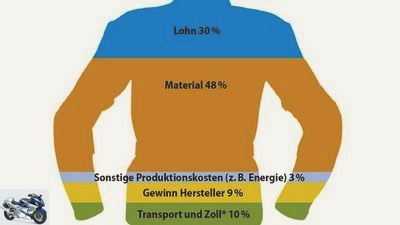
Share of costs in percent.
The composition of the retailer’s purchase price can be seen here using the example of a textile jacket with a high-quality Cordura outer fabric and Sympatex brand membrane. In the approximately twice as high end-consumer price, among other things. Marketing and sales costs (personnel, rent, advertising, etc.), VAT and the dealer’s profit included.
Countries of manufacture (using the example of the Polo motorcycle)
Just one example, namely the one for the accessories and clothing supplier Polo from Juchen, but a very typical example. Because the supplier world map looks like this or something similar for many suppliers. Portugal (including clothing) and Spain (including helmets) are other very popular European supplier countries; in Asia it is also Thailand and Laos.
Germany
- oil
- cleanser
Netherlands
- Leather bags
England
- Brake pads
Czech Republic
- Hand lever
Romania
- Shoes
Italy
- Tarpaulin
- Exhaust systems
- mirrors
Pakistan
- Leather and textile clothing
- gloves
- Boots
- Leather bags
Cambodia
- accessories
Vietnam
- Leather and textile clothing
- Helmets
Japan
- Batteries
- Air and oil filters
- Technical accessories (handles, indicators, attachments, etc.)
Indonesia
- Leather and textile clothing
- gloves
- Oil filter
Taiwan
- Technical accessories (handles, indicators, attachments, etc.)
China
- Leather and textile clothing
- Leisure wear
- Rainwear
- Helmets
- Protectors
- gloves
- Boots
- tool
- Tarpaulin
- Luggage
- accessories
- Batteries
- Tents
- Sleeping bags
interview
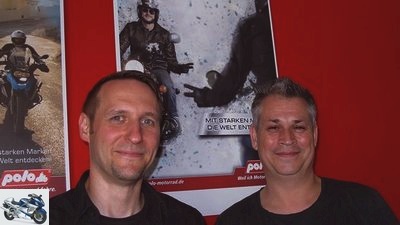
Klaus Herder
“Better informed and much more self-confident”
Polo employees Dennis Andreas (40, left, Head of Purchasing) and Marco Evers (50, Head of Technology Assortment) lured MOTORRAD to the Far East and then answered questions.
You are very often in Southeast Asia. What is your impression of current working conditions?
In recent years, the framework conditions for workers have become much, much more important. In China, for example, it is no longer enough for companies to provide a place to work and sleep. The Chinese worker wants to be well looked after, and that includes a decent kitchen and a good leisure program. Skilled workers are in great demand, and if they don’t like a company, they go to the neighbors, who look nicer and who have more to offer.
What about the observance of environmental regulations and occupational safety regulations?
A lot has happened there too. Not because those responsible have suddenly become good people, but because they have understood that this will avoid unrest and lure investors into the country. The employees all run around with smartphones and, unlike in the past, know pretty much what is going on in the world. You are better informed and much more confident.
What influence do you have on the working conditions??
We have introduced a “Code of Conduct” based on international regulations, a code of conduct that gives us guidelines for our own work, but also provides clear regulations, for example in terms of working hours, working conditions and the exclusion of child labor, and which we apply to the respective Translated national language, countersigned by our suppliers and we check compliance.
What exactly does the review look like??
We visit all production sites personally at regular intervals. When selecting suppliers, we pay attention to the high standards we have set. To check compliance, for example, we have an office in Shanghai with seven employees who are on the road for us in matters of quality assurance around the world and visit suppliers unannounced and also check compliance with the Code of Conduct. We receive a written report of every visit.
Related articles
-
jkuenstle.de 11 pictures wolf 1/11 Step 7: Now it’s the turn of the mouth. The worker puts the keys in a cassette and makes sure that all keys are…
-
Test: Online shops for motorcycle clothing and motorcycle accessories
Bilski clothing Test: Online shops for motorcycle clothing and motorcycle accessories Service: Sender test Online shops in a large comparison test Why…
-
Follow-up report product test Louis clothing combination
Monika Kuhlemann Club Follow-up report product test Louis clothing combination Review product test Louis Yes, that fits! Monika Kuhlemann and Thomas…
-
Practical test: clothing and accessories for touring riders
Bilski clothing Station wagons, jackets & pants Practical test: clothing and accessories for touring riders Practical test: clothing and accessories for…
-
motorcycles Report: BMW engine from China Report: BMW engine from China China Xcountry You don’t see it and you don’t hear it. Yeah, you don’t even feel…
-
Production: “Atlantis” leather suit by BMW
wolf 8th pictures wolf 1/8 Cutting: Tibi Hrdliczka is a trained master tailor and assembles 48 pieces of leather for a pair of trousers. For an Atlantis…
-
Original accessories Kawasaki Z 750
Bilski accesories Original accessories Kawasaki Z 750 Original accessories Kawasaki Z 750 Z-liner The Kawasaki Z 750 is one of the pleasant companions…
-
Textile, leather, helmets and accessories
Cavalieri clothing Textile, leather, helmets and accessories Textile, leather, helmets and accessories Trendsetter in motorcycle clothing Protectors, as…
-
Herder 27 pictures Herder 1/27 Herder 2/27 Tricycle? Nope, a four-wheeler. Americans stand on training wheels. And we hope that this trend will never…
-
Lights on motorcycle clothing and helmets
manufacturer 13th pictures manufacturer 1/13 The retrofittable Held Light System (HLS) is the latest development from Held. The LED modules light up…